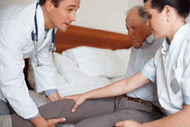
"Creepy crawly”, “pins and needles”, “tickles”, “itchy”, “numbness”,
“tingling”…these are just a few of the sensations that describe a
condition that approximately 10-20% of the population suffers from.
This condition is Restless Legs Syndrome, or RLS. WebMD defines RLS
as “a disorder of the nervous system in which there is an urge or
need to move the legs to stop unpleasant sensations” (1). These
sensations can often be defined medically as paresthesias and/or
dysesthesias in the calves and legs. About 50% of the patients with
RLS complain of restlessness in the arms as well (2).
Although it is found to be quite common, there is a lack of
awareness about the condition among the general population and
medical professionals. As the quote from the Restless Legs Syndrome
Organization states, restless legs syndrome is "the most common
disorder you've never heard of" (3). It often goes unrecognized or
misdiagnosed, with many individuals suffering 10 to 20 years with
the disorder until it is properly diagnosed and treated. What is
difficult about RLS is that instead of being able to diagnose it
through a specific clinical test, doctors must determine its
presence through a cluster of symptom characteristics such as the
following (1,3-4):
|
1. An urge to move the legs-- often accompanied or caused by
uncomfortable and unpleasant sensations in the legs |
|
2. Occurs during inactivity-- often when sitting or lying
down |
|
3. Symptoms partially or totally relieved by movement |
|
4. Onset in the evening-- usually while lying down at night
trying to fall asleep |
|
5. Feelings of daytime fatigue and tiredness-- due to
difficulty falling asleep and poor sleep patterns |
|
6. Leg twitching during sleep-- RLS can become a sleep
disorder when the twitching/jerking also occurs during sleep; then
it is called Periodic Limb Movement Disorder (PLMD). |
And although there are no specific medical tests to rule in the
diagnoses of RLS, many physicians use blood tests and other various
examinations to rule out other conditions, such as iron deficiency.
It is thought that many chronic diseases, medications, and stages of
life are associated with the development or worsening of RLS (1):
|
· Chronic Diseases: iron deficiency, diabetes, peripheral
neuropathy, Parkinson’s disease, kidney failure |
|
· Medications: anti-nausea drugs, antipsychotic drugs,
some antidepressants, cold and allergy medications |
|
· Pregnancy: often occurs in the last trimester and
usually spontaneously resides approximately one month postpartum |
|
· Lifestyle factors: high alcohol and caffeine use,
sleep deprivation, sedentary lifestyle |
|
· Genetics: Approximately 50% of people with RLS also
have a family member with the condition. Research in
the past few years has shed new light on the
potential influence of genetics on the incidence of
RLS. Gene scan studies in Iceland and the US have
found a strong association between certain
variations in the BTBD9 gene and the incidence of
RLS (5,6). In addition, it has been determined that
the BTBD9 gene regulates iron levels (and RLS has
commonly linked to iron deficiency). RLS is also
linked to a lack of dopamine; and individuals with
the BTBD9 gene variation were also found positive
for dopamine deficiency. |
The symptoms of Restless Legs Syndrome fall on a spectrum from mild
to severe, occasional to frequent, and with many people experiencing
major disturbances to quality of life. Patients with RLS often have
increased sleep latency, decreased sleep efficiency, and frequent
awakenings (4). In addition, patients also report headaches,
anxiety, social isolation, reduced libido and mild depression (4).
As a result, people suffering from RLS and its symptoms also
experience a mean productivity loss of 1 day/week, which results in
increased financial burden (7). The symptoms can vary in quality,
intensity, onset and duration. Like most conditions, people will
respond differently to different treatment approaches. It is
important for each individual to take action, and with the guidance
of a qualified medical professional, discover the most effective
treatment for them. The following are various therapeutic and
lifestyle approaches that can be taken to help in ameliorating the
symptoms of RLS (1,8):
Elevate and Exercise: Elevate your legs before bedtime. For
more severe symptoms, it could take anywhere from one to four hours
of elevation. One can add the following exercises to increase blood
flow and muscle activity throughout the body (8):
• Ankle pumps: Push the ankles down while curling the toes (1
sec), lift ankles up while fanning the toes (1 sec). Aim for 100
repetitions for every hour ankles are elevated.

• Quad sets and Glute sets: Tighten the gluteus maximus and
quadriceps for 5 second holds. Aim for 40-50 times for every hour
elevated.
• After work, perform dynamic, cardiovascular exercise that
involves large muscle groups such as walking, bicycling, swimming or
running for approximately 30 minutes in the evening.
Massage your feet and legs every night (better yet, have
someone else massage them if you can!). Perform circulation massage
technique, always massaging upwards towards the heart (preventing
fluid accumulation and irritation at your feet and lower legs).
Practice deep breathing: Stress has been known to aggravate
RLS symptoms. Take 10 slow, controlled, deep breathes in and out.
Engage in brain exercise: Distraction has been found to ease
RLS symptoms. Crossword puzzles, reading a book, or playing a board
game can be effective ways to exercise and distract the mind.
Try Yoga: Because it combines exercise, deep breathing and
relaxation, yoga combines three remedies known to reduce RLS
symptoms. Sign-up for a class or try an at-home video to learn the
proper postures and pace for you.
Turn off the TV before bedtime: Although sometimes relaxing,
the visual stimulation before bedtime has been known to aggravate
RLS symptoms.
Avoid alcohol and cigarettes: Although immediately relaxing,
alcohol and cigarettes can have triggering effects of RLS, and can
lead to overall poorer quality of sleep.
Review your medications: It is always a good idea to review
with your doctor to ensure none of your medications or supplements
are aggravating or causing your Restless Legs Syndrome.
Last revised: November, 18 2012
by Jennifer Werwie, DPT
References:
1) WebMD: Restless Legs Syndrome Center: http://www.webmd.com/brain/restless-legs-syndrome/restless-legs-syndrome-rls.
2) Michaud, et al. Arm Restlessness in Patient with Restless Legs
Syndrome. (2000) Movement Disorders. Mar;15(2):289-93.
3) Restless Leg Foundation. Website: http://www.rls.org/.
4) Agarwal P, Vaish N. Restless Legs Syndrome: Clinical
Manifestations. (2011) MedMerits. http://www.medmerits.com/index.php/article/restless_legs_syndrome/P2
5) Freeman, et al. Sleep Fragmentation and Motor Restlessness in a
Drosophila Model of Restless Legs Syndrome. (2012) Current Biology.
(22) 12:1142-1148.
6) Stefansson, H., David, B, et al. A Genetic Risk Factor for
Periodic Limb Movements in Sleep. (2007) New England Journal of
Medicine. 357:639-647.
7) Allen RP, et al. Prevalence and Disease Burden of Primary
Restless Legs Syndrome: Results of the General Populations Survey in
the United States. (2011) Movement Disorders. (26):114-120.
8) Linder, Bruce. “Restless Legs Syndrome and Physical Therapy.”
AllThingsPT.com: http://allthingspt.com/contact-us/#contact-form-81.









